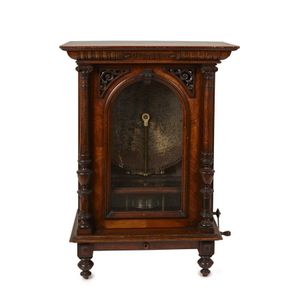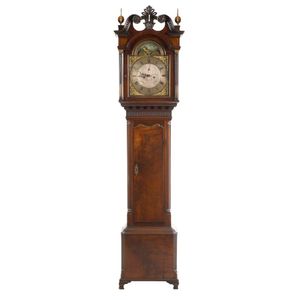Triple Fusee Walnut Bracket Clock with Palladian Pediment
You must be a subscriber, and be logged in to view price and dealer details.
Subscribe Now to view actual auction price for this item
When you subscribe, you have the option of setting the currency in which to display prices to $Au, $US, $NZ or Stg.
- Palladian - Andrea Palladio (1505-80), was an Italian architect and his building designs included use of pediments, cornices, lion masks, paws, acanthus leaves and swags. Palladio did not design any furniture, but his architectural elements have been carried through to furniture by other designers, the most notable of whom was Englishman, William Kent working in the first half of the 18th century.
- Spandrel - An architectural term that in horology refers to the triangular ornamental decoration in the corners of of the dial plate. The spandrels are usually of cast brass and may be additonally chased and engraved. On painted dial clocks the spandrels are also usually painted.
- Gilding - Gilding is a method of ornamentation whereby a thin sheet of gold metal is applied to items made of wood, leather, ceramics, glass and silver for decorative purposes.
For furniture including mirrors, the sheet of gold is usually applied over a coating of gesso. Gesso is a mixture of plaster of Paris and gypsum mixed with water and then applied to the carved wooden frames of mirrors and picture frames as a base for applying the gold leaf. After numerous coats of gesso have been applied, allowed to dry and then sanded a coat of "bole", a usually red coloured mixture of clay and glue is brushed on and allowed to dry, after which the gold leaf is applied. Over time parts of the gilding will rub off so the base colour can be seen. In water gilding, this was generally a blue colour, while in oil gilding, the under layer was often yellow. In Victorian times, gilders frequently used red as a pigment beneath the gold leaf.
Metal was often gilded by a process known as fire gilding. Gold mixed with mercury was applied and heated, causing the mercury to evaporate, the long-term effect of which was to kill or disable the craftsman or woman from mercury poisoning. The pursuit of beauty has claimed many victims, not the least of which were the artists who made those pieces so highly sought after today. - Rosewood - A dense timber that varies in shade to very light brown to almost black. When rosewood is cut and sanded the colour of the timber will turn black, and after polishing and exposure to daylight, the surface will gradually lighten over time to light brown with black streaks.
The name comes from the odour emanating from the timber when it is planed, sanded or cut.
Rosewood was very popular for use in Victorian furniture in the second half of the 19th century, and at that time most of the rosewood was imported from Brazil. However it also grows in India and Indonesia.
It is used in the sold for chairs and table legs, but for carcase furniture such as side cabinets and bookcases, and for table tops it is always used as a veneer. - Chapter Ring - A separate metal plate on the face of a clock, on which the numerals for the hours and sometimes parts of the hours, are displayed, usually wheel shaped and sitting on top of the dial plate. The chapter ring is often a feature of the clock and can be silvered or enamelled to stand as a contrast to its background. The hours are usually shown in Roman numerals, although in the late 19th and earlt 20th century, Arabic numerals became fashionable.
- Fusee - The fusee movement was used in clocks and pocket watches from the mid 17th century. The fusee is a cone shaped drum within the works that is linked to the barrel of the spring, usually by a length of chain.
As the mainspring loses its tension over time, the cone shaped barrel compensates for this by increasing the tension, by pulling the mainspring tighter, thus ensuring the time remains constant.
Use of the fusee in clocks was superseded by the "going barrel" in the mid 19th century and for pocket watches at the beginning of the 19th century.
The fusee continued to be used in marine chronometers until the 1970s.
This item has been included into following indexes:
Visually similar items

George III oak and rosewood long case clock by S Collier of Eccles, the caddy top hood with three brass urn finials and column uprights, the square and brass silverised dial with arabic and Roman numerals, engraved centre with painted subsidiary dial and a

A 19th century German upright Polyphon music machine with reproduction pediment, 'Penny in the Slot' walnut case with glass front and turned column sides. Together with ten music disks. Pediment with carved scallop shell and scroll over turned finial (one

George III longcase clock, the arched hood with three eagle and orb brass finials, fluted column supports, the arched painted dial with moonphase, Roman numerals, subsidiary second and calendar dials, in mahogany and inlaid case by Eli Tremfell of Lanham

A mahogany longcase clock, by John Aspinwall Liverpool, circa 1800, circular silvered dial framed by pierced spandrels, foliate engraved centre with subsidiary seconds dial and concentric calendar, signed John Aspinwall, Liverpool. The upper arch displays
